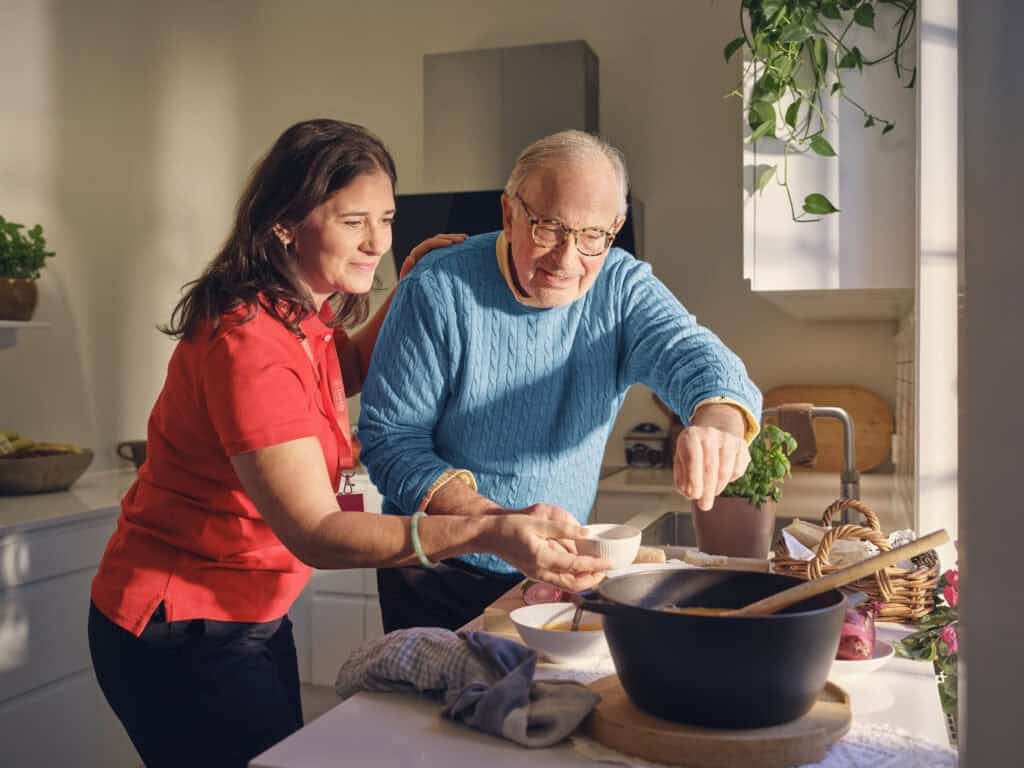Blog
12 June 2025
Palliative Care at Home
Palliative care in the home and beyond: how to navigate a delicate journey
Palliative care is a highly sensitive topic many prefer to avoid as it can trigger a raft of emotions such as grief and anxiety.
When most people hear the words palliative care, they immediately think of end-of-life situations and fear their loved one may only have weeks or even days left to live.
However, it’s important to remember that palliative care is not the same as end-of-life care. An individual can receive palliative care in the home or a care unit at any stage during their terminal illness or life-limiting condition, including while they are receiving treatment. In fact, palliative care in the home can be provided for many years.
What is palliative care?
Palliative care is specialised support for those diagnosed with a terminal illness or serious progressive condition such as cancer, end-stage organ disease, motor neurone disease or dementia.
Individuals can receive palliative care in the home or a care unit at a hospital or hospice, with the aim of improving quality of life by relieving pain and addressing their emotional, social and spiritual needs.
Palliative care specialists can also provide bereavement support for a patient’s loved one after their death.
Palliative Care Australia offers a wealth of resources including what services and supports available, such as:
- Services to alleviate pain and other symptoms
- Equipment and aids to support palliative care in the home
- Support for families having difficult conversations about future plans
- Assistance to determine future medical treatment that align with the patient’s goals
- Information about other supporting services eg. home care and financial support
- Support for emotional, social, cultural and spiritual concerns
- Counselling and bereavement support
- Referrals to respite care services
When should someone be offered palliative care?
Even when you have a good grasp of what palliative care entails, the matter of when should someone be offered palliative care isn’t always clear.
Palliative care is not just for the dying. It is highly beneficial to receive it early during a terminal illness, rather than just at the very end of life.
In fact, palliative care should be provided to anyone with a terminal illness or life-limiting condition who needs support to manage their symptoms such as pain, shortness of breath and nausea.
The specialised, person-centred care can also be offered to people of any age, including children.
So exactly when should someone be offered palliative care? There can be several signs that an individual could benefit from palliative care in the home or a care unit. These include persistent symptoms, frequent hospital admissions, increased frailness, progressive weight loss, and loss of function.
Just speaking with palliative care specialists can help a person understand their terminal illness, including how it will progress over time, what symptoms to expect and treatment options available to alleviate some of the symptoms. These discussions can also provide an opportunity to understand what equipment may be available.
This collaborative approach empowers individuals and their families to make informed decisions, including what healthcare, end-of-life and funeral preferences they want or do not want. For example, specialists can provide information about whether to continue treatment despite painful side effects, or whether to focus on comfort and quality of life.
The importance of palliative care
Australia’s rapidly ageing population means more people are living longer with chronic diseases and life-limiting illnesses.
This major demographic shift – and rising prevalence of conditions such as cancer and heart disease among the general population – is increasing demand for palliative care in the home and beyond.
About 80 per cent of expected deaths in Australia require palliative care – the current equivalent of about 2000 people each week, according to the Australian Institute of Health and Welfare (AIHW). And demand for palliative care is expected to double by 2050, according to a KPMG report.
Despite the growing importance of palliative care, there are still significant barriers that must be overcome to ensure all Australians can access it when they need it.
A major challenge is the shortage of palliative care specialists in many rural and remote areas, where access to general healthcare is already limited.
As a society, we also need to have more open conversations about palliative care or end-of-life options. It’s clear these topics aren’t being discussed enough, with statistics showing 70 per cent of Australians want to die at home, yet only 14 per cent do. This shows that, if given the choice, most people would prefer to receive palliative care in the home.
How to organise an end-of-life plan
End-of-life plans can be difficult to make but are essential following the diagnosis of a terminal illness.
These plans ensure the wishes of the individual can be met, especially if the terminal illness impacts their capacity to make or communicate decisions.
When formulating an end-of-life plan, it is important to consider:
- Where someone wishes to die – do they want to receive palliative care in the home, in a hospital or at a hospice?
- What kind of healthcare they wish to receive – also known as Advance Health Directives and Statement of Choices
- Who should make healthcare and other decisions for them – also known as Enduring Power of Attorneys (EOPA)
- What financial matters need to be organised and who should do this
- Whether the individual has a will, where this is stored and how has the ability to action the legally binding document.
For further information and advice about palliative care, it is best to speak to a GP, or an expert at Palliative Care Australia or Advance Care Planning Australia.

